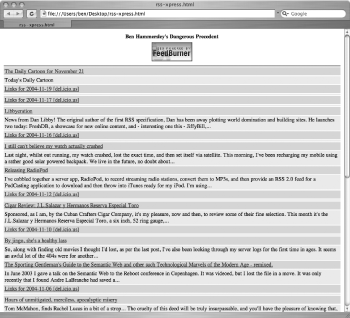JavaScript Display Parsers
The original use for RSS was to allow Netscape to display headlines and links on its My Netscape portal pages, and this sort of use remains very popular. But because you don’t need any programming skills to build a web site, nor a server that can run scripts to make it public, right from the beginning there has been a need for RSS parsers that live on other people’s servers and that web site authors can use without much trouble.
These JavaScript Display Parsers are still very popular, and there are many to go round. Each works pretty much the same way: you edit a snippet of JavaScript slightly and then place it inside a web page. Let’s look at one of these.
RSS XPress
Andy Powell and Pete Cliff’s RSS XPress system, found at http://rssxpress.ukoln.ac.uk/lite/, is an excellent example. Hosted by the U.K. Office for Library Networking at the University of Bath, it takes a feed’s URL and returns XHTML directly to the browser’s rendering engine. Example 8-1 shows a listing of a very basic web page that displays the RSS 1.0 file from my own weblog. Figure 8-1 shows how it looks in the Safari browser on Mac OS X.
 |
<html> <head></head> <body> <script src="http://rssxpress.ukoln.ac.uk/lite/viewer/?rss=http%3A%2F%2Fwww. benhammersley.com%2Findex.rdf"></script> ...
Get Developing Feeds with RSS and Atom now with the O’Reilly learning platform.
O’Reilly members experience books, live events, courses curated by job role, and more from O’Reilly and nearly 200 top publishers.

